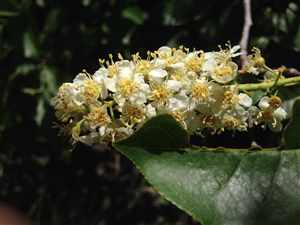Chokecherry (Prunus virginiana)
Main Facts about Chokecherry

Using Chokecherry
Making tea from inner bark treats diarrhea. A very popular common medicinal plant used to treat everything from indigestion to sore throat gargle. Lots of antioxidants and anthocyanins.The bark was boiled along with other ingredients to produce a remedy for diarrhea. A strong, black, astringent tea was made from boiled twigs and used to relieve fevers, coughing, malaria, stomachaches, tuberculosis and intestinal worms. Such teas were also used as sedatives and appetite stimulants. Dried roots were chewed and placed on wounds to stop bleeding. The fruit were used to treat canker sores, ulcers and abscesses.Chokecherry is a remedy for: Cold and flu, Anxiety
Cooking with Chokecherry
Fruit used in pies and jellies, syrops and wines.How to grow Chokecherry
Tolerates many types of soils including sand. Grows best in rich, well drained soils with sunny exposure. Will tolerate shade. Hardy and fast growing.Chokecherry Toxic Look-alikes
Cherry Laurel| Chamomile |
Cinnamon
|